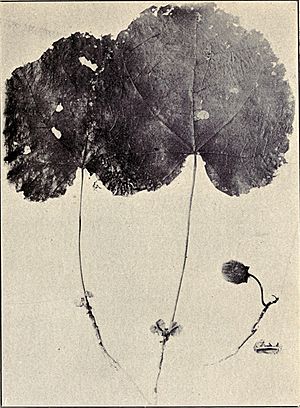Hualalai hau kuahiwi facts for kids
Quick facts for kids Hualalai hau kuahiwi |
|
|---|---|
 |
|
| Conservation status | |
| Scientific classification | |
| Genus: |
Hibiscadelphus
|
| Species: |
hualalaiensis
|
The Hibiscadelphus hualalaiensis, also known as Hualalai hau kuahiwi, is a special kind of flowering plant. It belongs to the mallow family, which includes many beautiful flowers like hibiscus. This plant is endemic to the Big Island of Hawaii. This means it naturally grows nowhere else in the world.
Sadly, the last known Hualalai hau kuahiwi plant in its natural home died in 1992. Because of this, it is now considered extinct in the wild. This means it no longer exists outside of human care. Any plants still alive are in danger because their natural home is being destroyed.
Contents
What is the Hualalai Hau Kuahiwi?
The Hualalai hau kuahiwi is a small tree. It can grow to be about 5 to 7 meters (16 to 23 feet) tall. Its trunk can be around 30 centimeters (12 inches) wide.
Where Did It Live?
This plant used to live in dry and mixed mesic forests. These forests are found on the slopes of the Hualālai volcano in Hawaii. It grew at heights between 915 and 1020 meters (about 3,000 to 3,350 feet) above sea level.
Plant Neighbors
The Hualalai hau kuahiwi shared its home with many other plants. Some of its neighbors included:
- ʻōhiʻa lehua (Metrosideros polymorpha)
- lama (Diospyros sandwicensis)
- māmane (Sophora chrysophylla)
- naio (Myoporum sandwicense)
- ʻālaʻa (Pouteria sandwicensis)
- pāpala (Charpentiera species)
- ʻaiea (Nothocestrum species)
- poʻolā (Claoxylon sandwicense)
- Kikuyu Grass (Pennisetum clandestinum)
Why is it Extinct in the Wild?
The main reason the Hualalai hau kuahiwi is gone from the wild is habitat loss. This happens when the natural places where plants and animals live are destroyed. This can be due to things like:
- Forests being cut down
- Land being used for building
- New plants or animals being introduced that harm the native ones
When a plant's home is destroyed, it can no longer survive there. This leads to the plant becoming very rare or even extinct.


